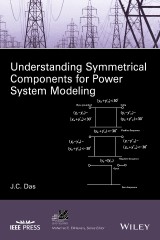Details

Understanding Symmetrical Components for Power System Modeling
IEEE Press Series on Power and Energy Systems 1. Aufl.
|
79,99 € |
|
| Verlag: | Wiley |
| Format: | |
| Veröffentl.: | 08.12.2016 |
| ISBN/EAN: | 9781119226871 |
| Sprache: | englisch |
| Anzahl Seiten: | 184 |
DRM-geschütztes eBook, Sie benötigen z.B. Adobe Digital Editions und eine Adobe ID zum Lesen.
Beschreibungen
<p><b>An essential guide to studying symmetrical component theory</b></p> <ul> <li>Provides concise treatment of symmetrical components</li> <li>Describes major sequence models of power system components</li> <li>Discusses Electromagnetic Transient Program (EMTP) models</li> <li>Includes worked examples to illustrate the complexity of calculations, followed by matrix methods of solution which have been adopted for calculations on digital computers</li> </ul>
ABOUT THE AUTHOR ix <p>FOREWORD xi</p> <p>PREFACE AND ACKNOWLEDGMENTS xiii</p> <p><b>CHAPTER 1 SYMMETRICAL COMPONENTS USING MATRIX METHODS 1</b></p> <p>1.1 Transformations 2</p> <p>1.2 Characteristic Roots, Eigenvalues, and Eigenvectors 2</p> <p>1.2.1 Definitions 2</p> <p>1.2.1.1 Characteristic Matrix 2</p> <p>1.2.1.2 Characteristic Polynomial 2</p> <p>1.2.1.3 Characteristic Equation 2</p> <p>1.2.1.4 Eigenvalues 2</p> <p>1.2.1.5 Eigenvectors, Characteristic Vectors 2</p> <p>1.3 Diagonalization of a Matrix 5</p> <p>1.4 Similarity Transformation 5</p> <p>1.5 Decoupling a Three-Phase Symmetrical System 6</p> <p>1.6 Symmetrical Component Transformation 8</p> <p>1.7 Decoupling a Three-Phase Unsymmetrical System 10</p> <p>1.8 Clarke Component Transformation 11</p> <p>1.9 Significance of Selection of Eigenvectors in Symmetrical Components 12</p> <p>References 14</p> <p><b>CHAPTER 2 FUNDAMENTAL CONCEPTS OF SYMMETRICAL COMPONENTS 15</b></p> <p>2.1 Characteristics of Symmetrical Components 16</p> <p>2.2 Characteristics of Sequence Networks 19</p> <p>2.3 Sequence Impedance of Network Components 20</p> <p>2.4 Construction of Sequence Networks 20</p> <p>2.5 Sequence Components of Transformers 22</p> <p>2.5.1 Delta-Wye or Wye-Delta Transformer 22</p> <p>2.5.2 Wye-Wye Transformer 25</p> <p>2.5.3 Delta-Delta Transformer 25</p> <p>2.5.4 Zigzag Transformer 25</p> <p>2.5.5 Three-Winding Transformers 27</p> <p>2.6 Example of Construction of Sequence Networks 32</p> <p>References 36</p> <p><b>CHAPTER 3 SYMMETRICAL COMPONENTS-TRANSMISSION LINES AND CABLES 39</b></p> <p>3.1 Impedance Matrix of Three-Phase Symmetrical Line 40</p> <p>3.2 Three-Phase Line with Ground Conductors 40</p> <p>3.3 Bundle Conductors 42</p> <p>3.4 Carson’s Formula 44</p> <p>3.4.1 Approximations to Carson’s Equations 46</p> <p>3.5 Capacitance of Lines 50</p> <p>3.5.1 Capacitance Matrix 50</p> <p>3.6 Cable Constants 54</p> <p>3.6.1 Zero Sequence Impedance of the OH lines and Cables 54</p> <p>3.6.2 Concentric Neutral Underground Cable 55</p> <p>3.6.3 Capacitance of Cables 57</p> <p>3.7 EMTP Models 58</p> <p>3.7.1 Frequency Dependent Model, FD 60</p> <p>3.8 Effect of Harmonics on Line Models 62</p> <p>3.9 Transmission Line Equations with Harmonics 62</p> <p>References 66</p> <p><b>CHAPTER 4 SEQUENCE IMPEDANCES OF ROTATING EQUIPMENT AND STATIC LOAD 69</b></p> <p>4.1 Synchronous Generators 69</p> <p>4.1.1 Positive Sequence Impedance 69</p> <p>4.1.2 Negative Sequence Impedance 70</p> <p>4.1.3 Negative Sequence Capability of Generators 71</p> <p>4.1.3.1 Effect of Harmonics 71</p> <p>4.1.4 Zero Sequence Impedance 73</p> <p>4.1.5 Sequence Component Transformation 75</p> <p>4.1.6 Three-Phase Short-Circuit of a Generator 77</p> <p>4.1.7 Park’s Transformation 79</p> <p>4.2 Induction Motors 81</p> <p>4.2.1 Equivalent Circuit 81</p> <p>4.2.2 Negative Sequence Impedance 83</p> <p>4.2.3 Harmonic Impedances 84</p> <p>4.2.4 Zero Sequence Impedance 86</p> <p>4.2.5 Terminal Short-Circuit of an Induction Motor 86</p> <p>4.3 Static Loads 87</p> <p>4.4 Harmonics and Sequence Components 87</p> <p>References 88</p> <p>Further Reading 89</p> <p><b>CHAPTER 5 THREE-PHASE MODELS OF TRANSFORMERS AND CONDUCTORS 91</b></p> <p>5.1 Three-Phase Models 91</p> <p>5.2 Three-Phase Transformer Models 91</p> <p>5.2.1 Symmetrical Components of Three-Phase Transformers 94</p> <p>5.3 Conductors 99</p> <p>References 102</p> <p><b>CHAPTER 6 UNSYMMETRICAL FAULT CALCULATIONS 103</b></p> <p>6.1 Line-to-Ground Fault 104</p> <p>6.2 Line-to-Line Fault 106</p> <p>6.3 Double Line-to-Ground Fault 107</p> <p>6.4 Three-Phase Fault 109</p> <p>6.5 Phase Shift in Three-Phase Transformer Windings 110</p> <p>6.5.1 Transformer Connections 110</p> <p>6.5.2 Phase Shifts in Winding as per Standards 112</p> <p>6.5.3 Phase Shift for Negative Sequence Components 115</p> <p>6.6 Unsymmetrical Long Hand Fault Calculations 116</p> <p>6.7 Open Conductor Faults 126</p> <p>6.7.1 Two Conductor Open Fault 126</p> <p>6.7.2 One Conductor Open Fault 127</p> <p>6.8 Short-Circuit Calculations with Bus Impedance Matrix 131</p> <p>6.8.1 Line-to-Ground Fault 131</p> <p>6.8.2 Line-to-Line Fault 131</p> <p>6.8.3 Double Line-to-Ground Fault 131</p> <p>6.8.4 Calculation Procedure 133</p> <p>6.9 System Grounding 138</p> <p>6.9.1 Solidly Grounded Systems 140</p> <p>6.9.2 Resistance Grounded Systems 140</p> <p>6.9.3 High-Resistance Grounded Systems 141</p> <p>6.9.4 Coefficient of Grounding 143</p> <p>References 145</p> <p>Further Reading 145</p> <p><b>CHAPTER 7 SOME LIMITATIONS OF SYMMETRICAL COMPONENTS 147</b></p> <p>7.1 Phase Coordinate Method 148</p> <p>7.2 Three-Phase Models 150</p> <p>7.2.1 Generators 150</p> <p>7.2.2 Generator Model for Cogeneration 152</p> <p>7.2.3 Load Models 152</p> <p>7.3 Multiple Grounded Systems 154</p> <p>7.3.1 Equivalent Circuit of Multiple Grounded Systems 156</p> <p>7.3.2 Equivalent Circuit Approach 156</p> <p>References 158</p> <p>INDEX 159</p>
"This book provides good technical depth, yet also provides a practical treatment of symmetrical components"..."This would be a very good book for power system engineers" <b>IEEE, Oct 2017</b>
<p><b>J.C. Das</b> is President, Power System Studies, Inc. Snellville, Georgia. He is an independent consultant, currently with AMEC Foster Wheeler, Inc., a leading supplier of high-value consultancy, engineering, and project management services to the world's energy, power, and process industries. He is the author of IEEE Press titles <i>Power System Harmonics and Passive Filter Designs</i> (2015) and <i>Arc Flash Hazard Analysis and Mitigation</i> (2012).</p>
<p><b>An essential guide to studying symmetrical component theory</b></p> <p>This book utilizes symmetrical components for analyzing unbalanced three-phase electrical systems, by applying single-phase analysis tools. The author covers two approaches for studying symmetrical components; the physical approach, avoiding many mathematical matrix algebra equations, and a mathematical approach, using matrix theory. Divided into seven sections, topics include: symmetrical components using matrix methods, fundamental concepts of symmetrical components, symmetrical component s –transmission lines and cables, sequence components of rotating equipment and static load, three-phase models of transformers and conductors, unsymmetrical fault calculations, and some limitations of symmetrical components. In addition, this book:</p> <ul> <li>Provides concise treatment of symmetrical components</li> <li>Describes major sequence models of power system components</li> <li>Discusses Electromagnetic Transient Program (EMTP) models</li> <li>Includes worked examples to illustrate the complexity of calculations, followed by matrix methods of solution which have been adopted for calculations on digital computers</li> </ul>

















